University Nursing Report: Trauma Informed Care for LGBTQ Youth Review
VerifiedAdded on 2022/08/26
|10
|2474
|25
Report
AI Summary
This report provides a comprehensive literature review on Trauma Informed Care (TIC) for LGBTQ youth, addressing the increased acceptance of this population in contemporary society and the disproportionate impact of childhood trauma, including sexual abuse, physical abuse, and peer violence. The report defines TIC and explores evidence from the literature, highlighting the prevalence of PTSD and the impact of factors like family rejection and gender nonconformity. It outlines effective evaluation tools, although specific tools are not clearly elucidated in the provided literature, it references frameworks like the 12 core concepts for understanding traumatic stress responses in childhood and tools like CANS Trauma Version, EQ-i:YV, and AAVHTQ. The report also focuses on re-traumatization, specifically addressing physical assault and its reduction in clinical settings, emphasizing the importance of sensitivity, psychoeducation, building resilience, and peer support to prevent re-traumatization. The conclusion emphasizes the vulnerability of LGBTQ youth to trauma and the need for TIC strategies like psychoeducation and peer support to improve their health outcomes. The report is based on a student's work and is available on Desklib, a platform offering study tools for students.
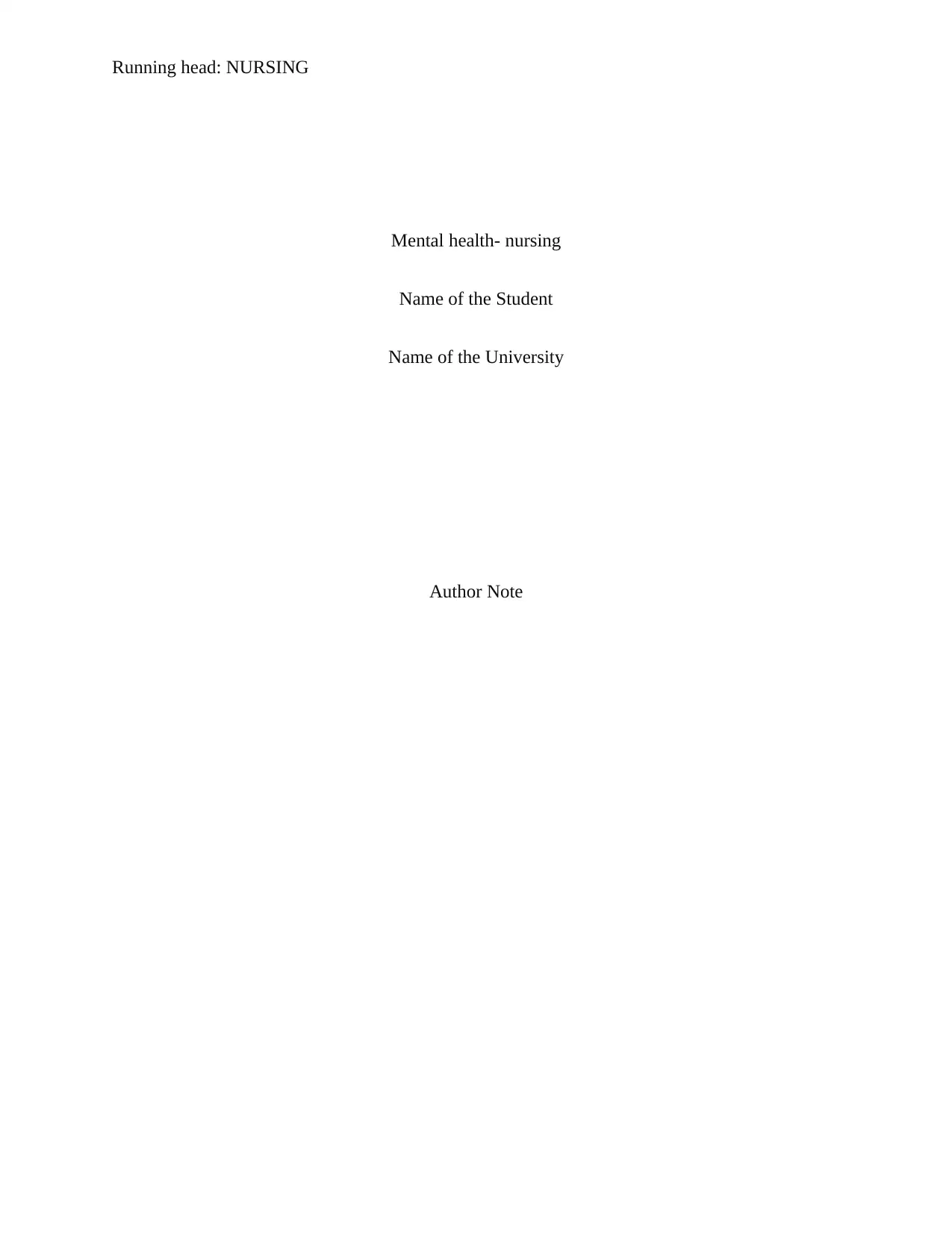
Running head: NURSING
Mental health- nursing
Name of the Student
Name of the University
Author Note
Mental health- nursing
Name of the Student
Name of the University
Author Note
Paraphrase This Document
Need a fresh take? Get an instant paraphrase of this document with our AI Paraphraser
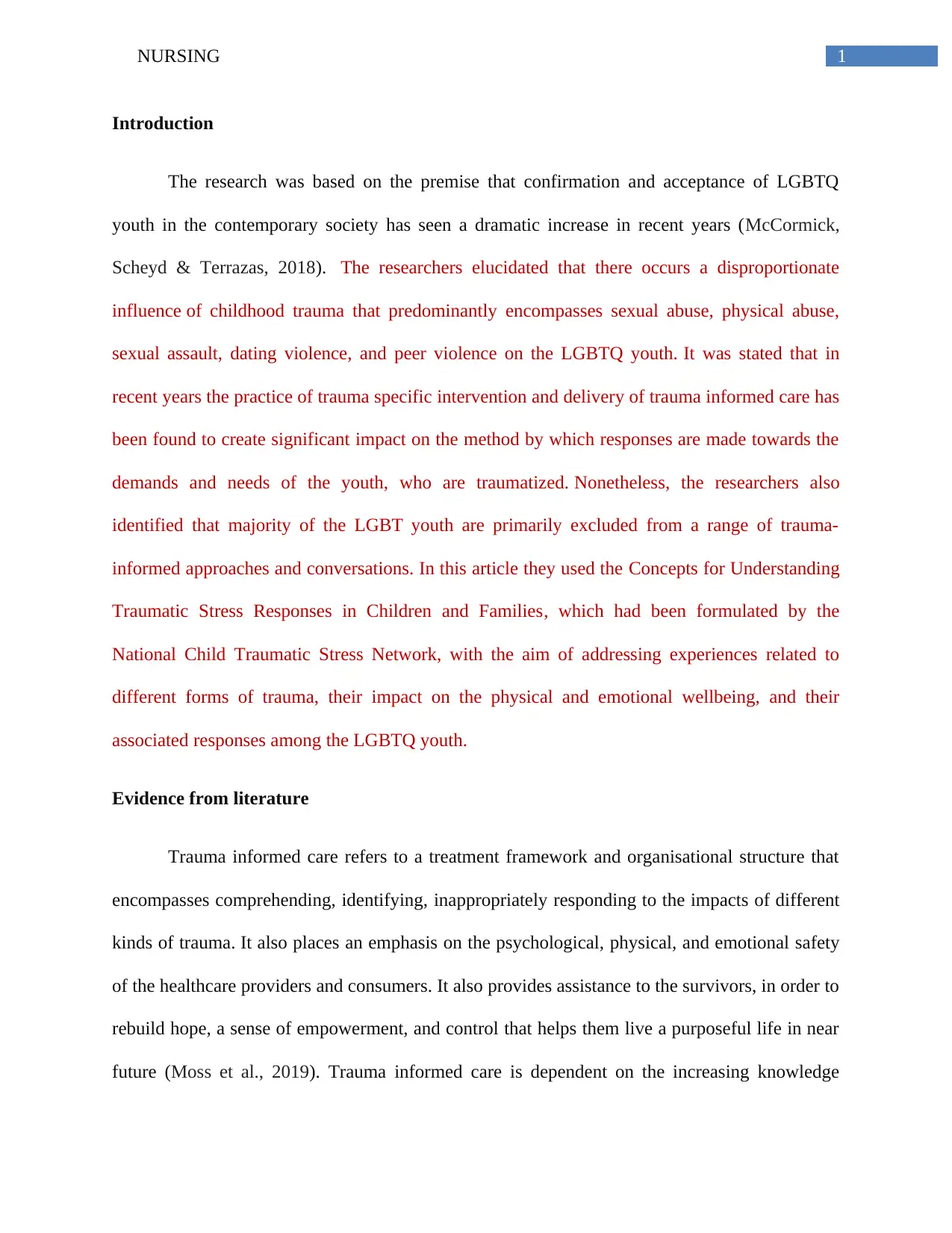
1NURSING
Introduction
The research was based on the premise that confirmation and acceptance of LGBTQ
youth in the contemporary society has seen a dramatic increase in recent years (McCormick,
Scheyd & Terrazas, 2018). The researchers elucidated that there occurs a disproportionate
influence of childhood trauma that predominantly encompasses sexual abuse, physical abuse,
sexual assault, dating violence, and peer violence on the LGBTQ youth. It was stated that in
recent years the practice of trauma specific intervention and delivery of trauma informed care has
been found to create significant impact on the method by which responses are made towards the
demands and needs of the youth, who are traumatized. Nonetheless, the researchers also
identified that majority of the LGBT youth are primarily excluded from a range of trauma-
informed approaches and conversations. In this article they used the Concepts for Understanding
Traumatic Stress Responses in Children and Families, which had been formulated by the
National Child Traumatic Stress Network, with the aim of addressing experiences related to
different forms of trauma, their impact on the physical and emotional wellbeing, and their
associated responses among the LGBTQ youth.
Evidence from literature
Trauma informed care refers to a treatment framework and organisational structure that
encompasses comprehending, identifying, inappropriately responding to the impacts of different
kinds of trauma. It also places an emphasis on the psychological, physical, and emotional safety
of the healthcare providers and consumers. It also provides assistance to the survivors, in order to
rebuild hope, a sense of empowerment, and control that helps them live a purposeful life in near
future (Moss et al., 2019). Trauma informed care is dependent on the increasing knowledge
Introduction
The research was based on the premise that confirmation and acceptance of LGBTQ
youth in the contemporary society has seen a dramatic increase in recent years (McCormick,
Scheyd & Terrazas, 2018). The researchers elucidated that there occurs a disproportionate
influence of childhood trauma that predominantly encompasses sexual abuse, physical abuse,
sexual assault, dating violence, and peer violence on the LGBTQ youth. It was stated that in
recent years the practice of trauma specific intervention and delivery of trauma informed care has
been found to create significant impact on the method by which responses are made towards the
demands and needs of the youth, who are traumatized. Nonetheless, the researchers also
identified that majority of the LGBT youth are primarily excluded from a range of trauma-
informed approaches and conversations. In this article they used the Concepts for Understanding
Traumatic Stress Responses in Children and Families, which had been formulated by the
National Child Traumatic Stress Network, with the aim of addressing experiences related to
different forms of trauma, their impact on the physical and emotional wellbeing, and their
associated responses among the LGBTQ youth.
Evidence from literature
Trauma informed care refers to a treatment framework and organisational structure that
encompasses comprehending, identifying, inappropriately responding to the impacts of different
kinds of trauma. It also places an emphasis on the psychological, physical, and emotional safety
of the healthcare providers and consumers. It also provides assistance to the survivors, in order to
rebuild hope, a sense of empowerment, and control that helps them live a purposeful life in near
future (Moss et al., 2019). Trauma informed care is dependent on the increasing knowledge
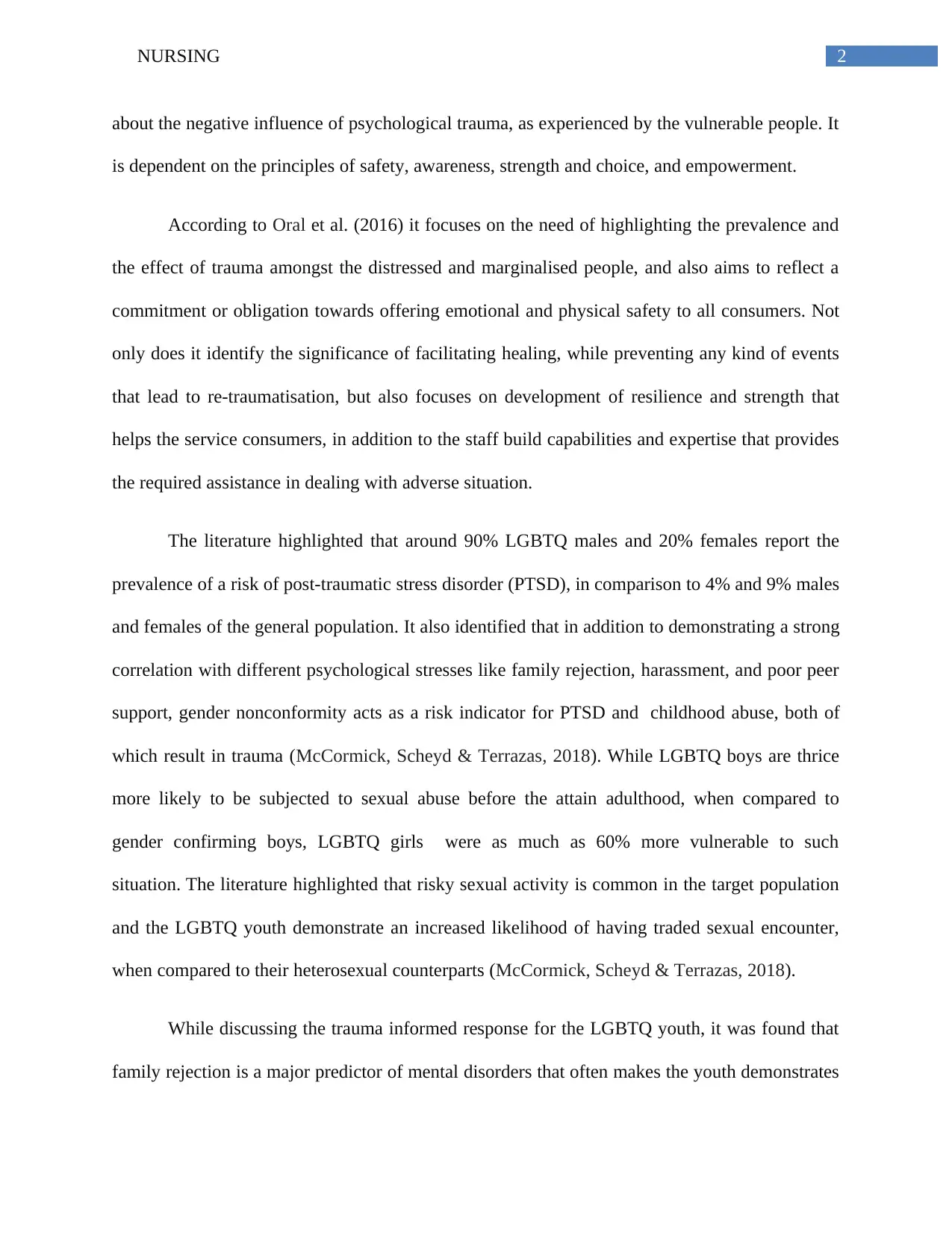
2NURSING
about the negative influence of psychological trauma, as experienced by the vulnerable people. It
is dependent on the principles of safety, awareness, strength and choice, and empowerment.
According to Oral et al. (2016) it focuses on the need of highlighting the prevalence and
the effect of trauma amongst the distressed and marginalised people, and also aims to reflect a
commitment or obligation towards offering emotional and physical safety to all consumers. Not
only does it identify the significance of facilitating healing, while preventing any kind of events
that lead to re-traumatisation, but also focuses on development of resilience and strength that
helps the service consumers, in addition to the staff build capabilities and expertise that provides
the required assistance in dealing with adverse situation.
The literature highlighted that around 90% LGBTQ males and 20% females report the
prevalence of a risk of post-traumatic stress disorder (PTSD), in comparison to 4% and 9% males
and females of the general population. It also identified that in addition to demonstrating a strong
correlation with different psychological stresses like family rejection, harassment, and poor peer
support, gender nonconformity acts as a risk indicator for PTSD and childhood abuse, both of
which result in trauma (McCormick, Scheyd & Terrazas, 2018). While LGBTQ boys are thrice
more likely to be subjected to sexual abuse before the attain adulthood, when compared to
gender confirming boys, LGBTQ girls were as much as 60% more vulnerable to such
situation. The literature highlighted that risky sexual activity is common in the target population
and the LGBTQ youth demonstrate an increased likelihood of having traded sexual encounter,
when compared to their heterosexual counterparts (McCormick, Scheyd & Terrazas, 2018).
While discussing the trauma informed response for the LGBTQ youth, it was found that
family rejection is a major predictor of mental disorders that often makes the youth demonstrates
about the negative influence of psychological trauma, as experienced by the vulnerable people. It
is dependent on the principles of safety, awareness, strength and choice, and empowerment.
According to Oral et al. (2016) it focuses on the need of highlighting the prevalence and
the effect of trauma amongst the distressed and marginalised people, and also aims to reflect a
commitment or obligation towards offering emotional and physical safety to all consumers. Not
only does it identify the significance of facilitating healing, while preventing any kind of events
that lead to re-traumatisation, but also focuses on development of resilience and strength that
helps the service consumers, in addition to the staff build capabilities and expertise that provides
the required assistance in dealing with adverse situation.
The literature highlighted that around 90% LGBTQ males and 20% females report the
prevalence of a risk of post-traumatic stress disorder (PTSD), in comparison to 4% and 9% males
and females of the general population. It also identified that in addition to demonstrating a strong
correlation with different psychological stresses like family rejection, harassment, and poor peer
support, gender nonconformity acts as a risk indicator for PTSD and childhood abuse, both of
which result in trauma (McCormick, Scheyd & Terrazas, 2018). While LGBTQ boys are thrice
more likely to be subjected to sexual abuse before the attain adulthood, when compared to
gender confirming boys, LGBTQ girls were as much as 60% more vulnerable to such
situation. The literature highlighted that risky sexual activity is common in the target population
and the LGBTQ youth demonstrate an increased likelihood of having traded sexual encounter,
when compared to their heterosexual counterparts (McCormick, Scheyd & Terrazas, 2018).
While discussing the trauma informed response for the LGBTQ youth, it was found that
family rejection is a major predictor of mental disorders that often makes the youth demonstrates
⊘ This is a preview!⊘
Do you want full access?
Subscribe today to unlock all pages.

Trusted by 1+ million students worldwide
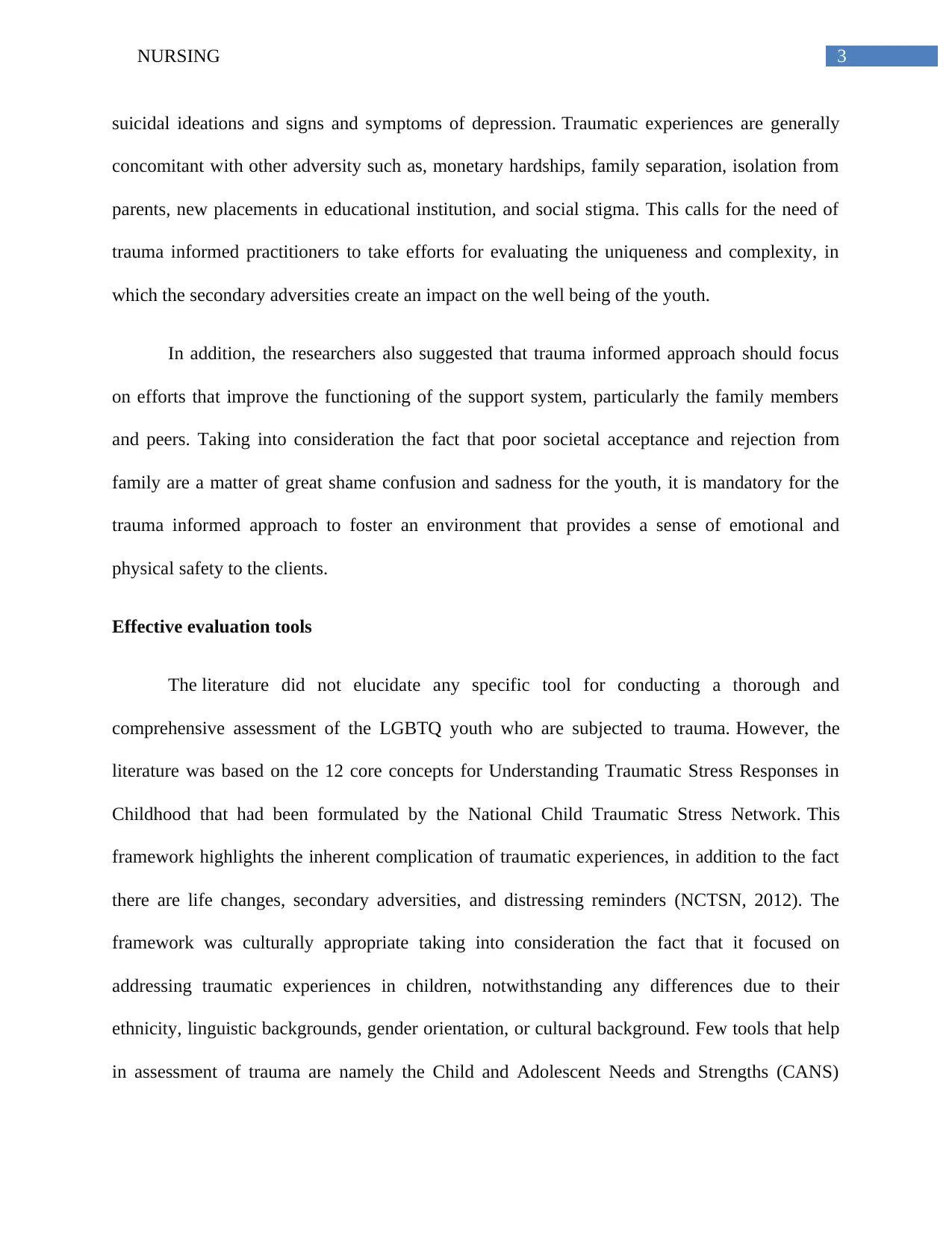
3NURSING
suicidal ideations and signs and symptoms of depression. Traumatic experiences are generally
concomitant with other adversity such as, monetary hardships, family separation, isolation from
parents, new placements in educational institution, and social stigma. This calls for the need of
trauma informed practitioners to take efforts for evaluating the uniqueness and complexity, in
which the secondary adversities create an impact on the well being of the youth.
In addition, the researchers also suggested that trauma informed approach should focus
on efforts that improve the functioning of the support system, particularly the family members
and peers. Taking into consideration the fact that poor societal acceptance and rejection from
family are a matter of great shame confusion and sadness for the youth, it is mandatory for the
trauma informed approach to foster an environment that provides a sense of emotional and
physical safety to the clients.
Effective evaluation tools
The literature did not elucidate any specific tool for conducting a thorough and
comprehensive assessment of the LGBTQ youth who are subjected to trauma. However, the
literature was based on the 12 core concepts for Understanding Traumatic Stress Responses in
Childhood that had been formulated by the National Child Traumatic Stress Network. This
framework highlights the inherent complication of traumatic experiences, in addition to the fact
there are life changes, secondary adversities, and distressing reminders (NCTSN, 2012). The
framework was culturally appropriate taking into consideration the fact that it focused on
addressing traumatic experiences in children, notwithstanding any differences due to their
ethnicity, linguistic backgrounds, gender orientation, or cultural background. Few tools that help
in assessment of trauma are namely the Child and Adolescent Needs and Strengths (CANS)
suicidal ideations and signs and symptoms of depression. Traumatic experiences are generally
concomitant with other adversity such as, monetary hardships, family separation, isolation from
parents, new placements in educational institution, and social stigma. This calls for the need of
trauma informed practitioners to take efforts for evaluating the uniqueness and complexity, in
which the secondary adversities create an impact on the well being of the youth.
In addition, the researchers also suggested that trauma informed approach should focus
on efforts that improve the functioning of the support system, particularly the family members
and peers. Taking into consideration the fact that poor societal acceptance and rejection from
family are a matter of great shame confusion and sadness for the youth, it is mandatory for the
trauma informed approach to foster an environment that provides a sense of emotional and
physical safety to the clients.
Effective evaluation tools
The literature did not elucidate any specific tool for conducting a thorough and
comprehensive assessment of the LGBTQ youth who are subjected to trauma. However, the
literature was based on the 12 core concepts for Understanding Traumatic Stress Responses in
Childhood that had been formulated by the National Child Traumatic Stress Network. This
framework highlights the inherent complication of traumatic experiences, in addition to the fact
there are life changes, secondary adversities, and distressing reminders (NCTSN, 2012). The
framework was culturally appropriate taking into consideration the fact that it focused on
addressing traumatic experiences in children, notwithstanding any differences due to their
ethnicity, linguistic backgrounds, gender orientation, or cultural background. Few tools that help
in assessment of trauma are namely the Child and Adolescent Needs and Strengths (CANS)
Paraphrase This Document
Need a fresh take? Get an instant paraphrase of this document with our AI Paraphraser
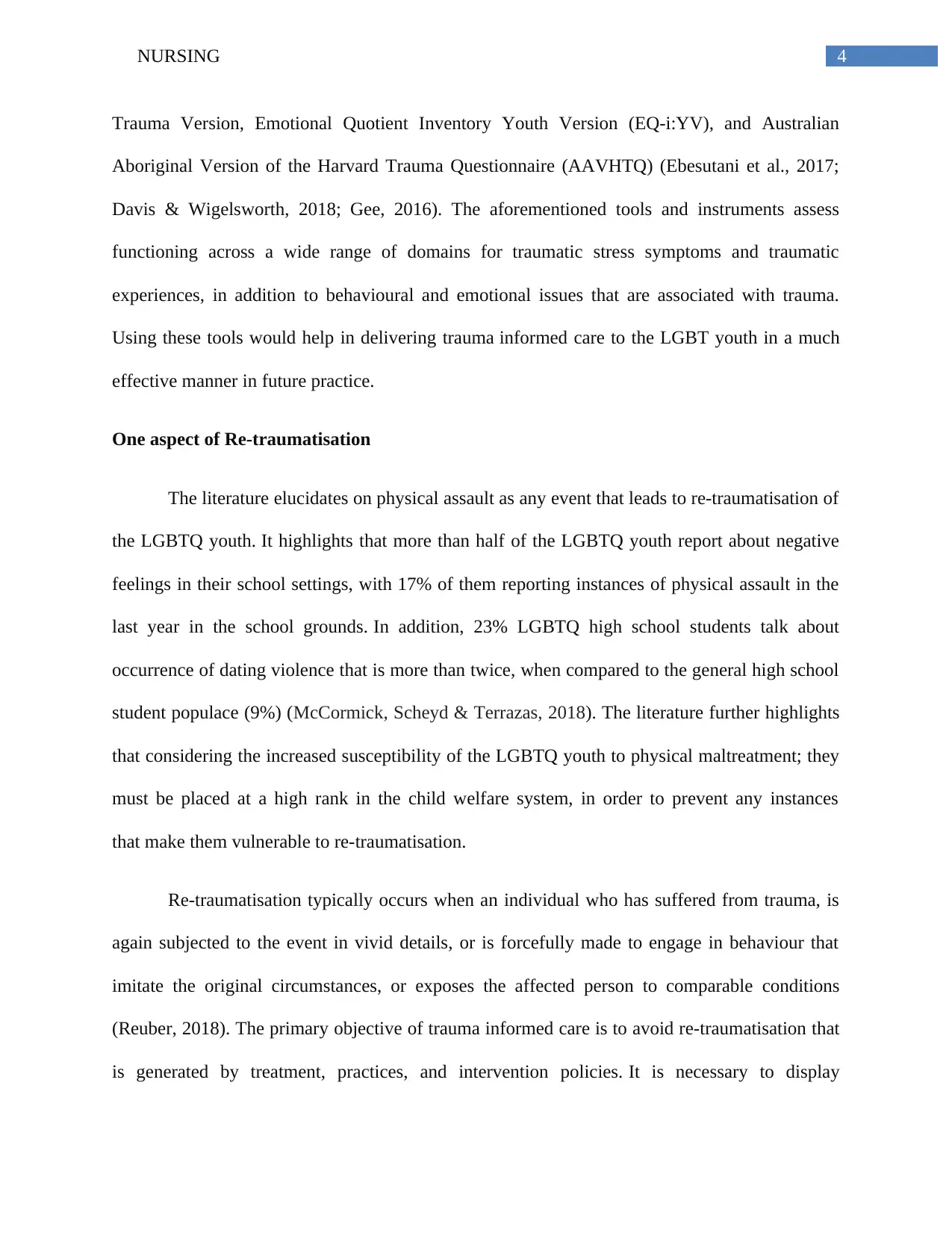
4NURSING
Trauma Version, Emotional Quotient Inventory Youth Version (EQ-i:YV), and Australian
Aboriginal Version of the Harvard Trauma Questionnaire (AAVHTQ) (Ebesutani et al., 2017;
Davis & Wigelsworth, 2018; Gee, 2016). The aforementioned tools and instruments assess
functioning across a wide range of domains for traumatic stress symptoms and traumatic
experiences, in addition to behavioural and emotional issues that are associated with trauma.
Using these tools would help in delivering trauma informed care to the LGBT youth in a much
effective manner in future practice.
One aspect of Re-traumatisation
The literature elucidates on physical assault as any event that leads to re-traumatisation of
the LGBTQ youth. It highlights that more than half of the LGBTQ youth report about negative
feelings in their school settings, with 17% of them reporting instances of physical assault in the
last year in the school grounds. In addition, 23% LGBTQ high school students talk about
occurrence of dating violence that is more than twice, when compared to the general high school
student populace (9%) (McCormick, Scheyd & Terrazas, 2018). The literature further highlights
that considering the increased susceptibility of the LGBTQ youth to physical maltreatment; they
must be placed at a high rank in the child welfare system, in order to prevent any instances
that make them vulnerable to re-traumatisation.
Re-traumatisation typically occurs when an individual who has suffered from trauma, is
again subjected to the event in vivid details, or is forcefully made to engage in behaviour that
imitate the original circumstances, or exposes the affected person to comparable conditions
(Reuber, 2018). The primary objective of trauma informed care is to avoid re-traumatisation that
is generated by treatment, practices, and intervention policies. It is necessary to display
Trauma Version, Emotional Quotient Inventory Youth Version (EQ-i:YV), and Australian
Aboriginal Version of the Harvard Trauma Questionnaire (AAVHTQ) (Ebesutani et al., 2017;
Davis & Wigelsworth, 2018; Gee, 2016). The aforementioned tools and instruments assess
functioning across a wide range of domains for traumatic stress symptoms and traumatic
experiences, in addition to behavioural and emotional issues that are associated with trauma.
Using these tools would help in delivering trauma informed care to the LGBT youth in a much
effective manner in future practice.
One aspect of Re-traumatisation
The literature elucidates on physical assault as any event that leads to re-traumatisation of
the LGBTQ youth. It highlights that more than half of the LGBTQ youth report about negative
feelings in their school settings, with 17% of them reporting instances of physical assault in the
last year in the school grounds. In addition, 23% LGBTQ high school students talk about
occurrence of dating violence that is more than twice, when compared to the general high school
student populace (9%) (McCormick, Scheyd & Terrazas, 2018). The literature further highlights
that considering the increased susceptibility of the LGBTQ youth to physical maltreatment; they
must be placed at a high rank in the child welfare system, in order to prevent any instances
that make them vulnerable to re-traumatisation.
Re-traumatisation typically occurs when an individual who has suffered from trauma, is
again subjected to the event in vivid details, or is forcefully made to engage in behaviour that
imitate the original circumstances, or exposes the affected person to comparable conditions
(Reuber, 2018). The primary objective of trauma informed care is to avoid re-traumatisation that
is generated by treatment, practices, and intervention policies. It is necessary to display
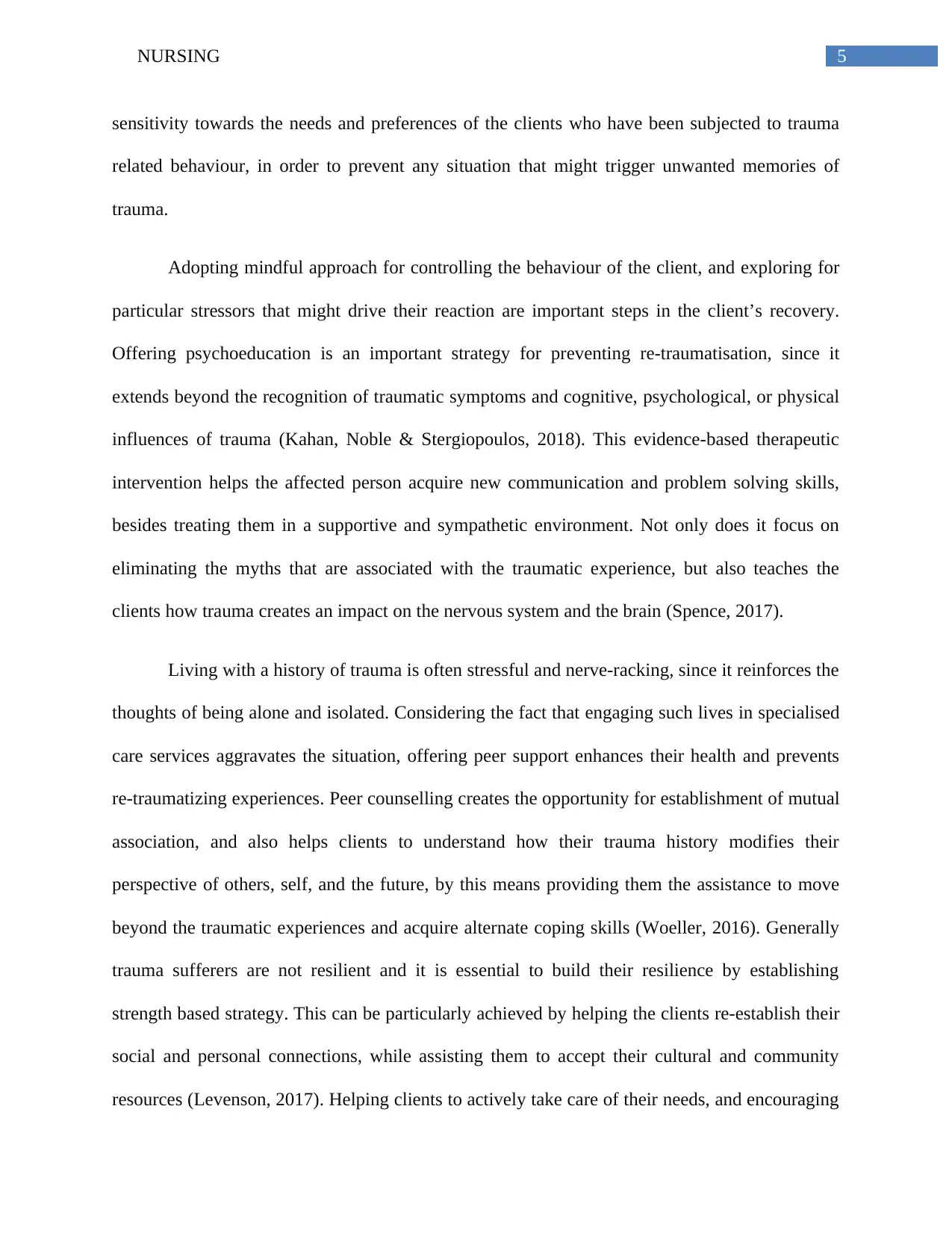
5NURSING
sensitivity towards the needs and preferences of the clients who have been subjected to trauma
related behaviour, in order to prevent any situation that might trigger unwanted memories of
trauma.
Adopting mindful approach for controlling the behaviour of the client, and exploring for
particular stressors that might drive their reaction are important steps in the client’s recovery.
Offering psychoeducation is an important strategy for preventing re-traumatisation, since it
extends beyond the recognition of traumatic symptoms and cognitive, psychological, or physical
influences of trauma (Kahan, Noble & Stergiopoulos, 2018). This evidence-based therapeutic
intervention helps the affected person acquire new communication and problem solving skills,
besides treating them in a supportive and sympathetic environment. Not only does it focus on
eliminating the myths that are associated with the traumatic experience, but also teaches the
clients how trauma creates an impact on the nervous system and the brain (Spence, 2017).
Living with a history of trauma is often stressful and nerve-racking, since it reinforces the
thoughts of being alone and isolated. Considering the fact that engaging such lives in specialised
care services aggravates the situation, offering peer support enhances their health and prevents
re-traumatizing experiences. Peer counselling creates the opportunity for establishment of mutual
association, and also helps clients to understand how their trauma history modifies their
perspective of others, self, and the future, by this means providing them the assistance to move
beyond the traumatic experiences and acquire alternate coping skills (Woeller, 2016). Generally
trauma sufferers are not resilient and it is essential to build their resilience by establishing
strength based strategy. This can be particularly achieved by helping the clients re-establish their
social and personal connections, while assisting them to accept their cultural and community
resources (Levenson, 2017). Helping clients to actively take care of their needs, and encouraging
sensitivity towards the needs and preferences of the clients who have been subjected to trauma
related behaviour, in order to prevent any situation that might trigger unwanted memories of
trauma.
Adopting mindful approach for controlling the behaviour of the client, and exploring for
particular stressors that might drive their reaction are important steps in the client’s recovery.
Offering psychoeducation is an important strategy for preventing re-traumatisation, since it
extends beyond the recognition of traumatic symptoms and cognitive, psychological, or physical
influences of trauma (Kahan, Noble & Stergiopoulos, 2018). This evidence-based therapeutic
intervention helps the affected person acquire new communication and problem solving skills,
besides treating them in a supportive and sympathetic environment. Not only does it focus on
eliminating the myths that are associated with the traumatic experience, but also teaches the
clients how trauma creates an impact on the nervous system and the brain (Spence, 2017).
Living with a history of trauma is often stressful and nerve-racking, since it reinforces the
thoughts of being alone and isolated. Considering the fact that engaging such lives in specialised
care services aggravates the situation, offering peer support enhances their health and prevents
re-traumatizing experiences. Peer counselling creates the opportunity for establishment of mutual
association, and also helps clients to understand how their trauma history modifies their
perspective of others, self, and the future, by this means providing them the assistance to move
beyond the traumatic experiences and acquire alternate coping skills (Woeller, 2016). Generally
trauma sufferers are not resilient and it is essential to build their resilience by establishing
strength based strategy. This can be particularly achieved by helping the clients re-establish their
social and personal connections, while assisting them to accept their cultural and community
resources (Levenson, 2017). Helping clients to actively take care of their needs, and encouraging
⊘ This is a preview!⊘
Do you want full access?
Subscribe today to unlock all pages.

Trusted by 1+ million students worldwide
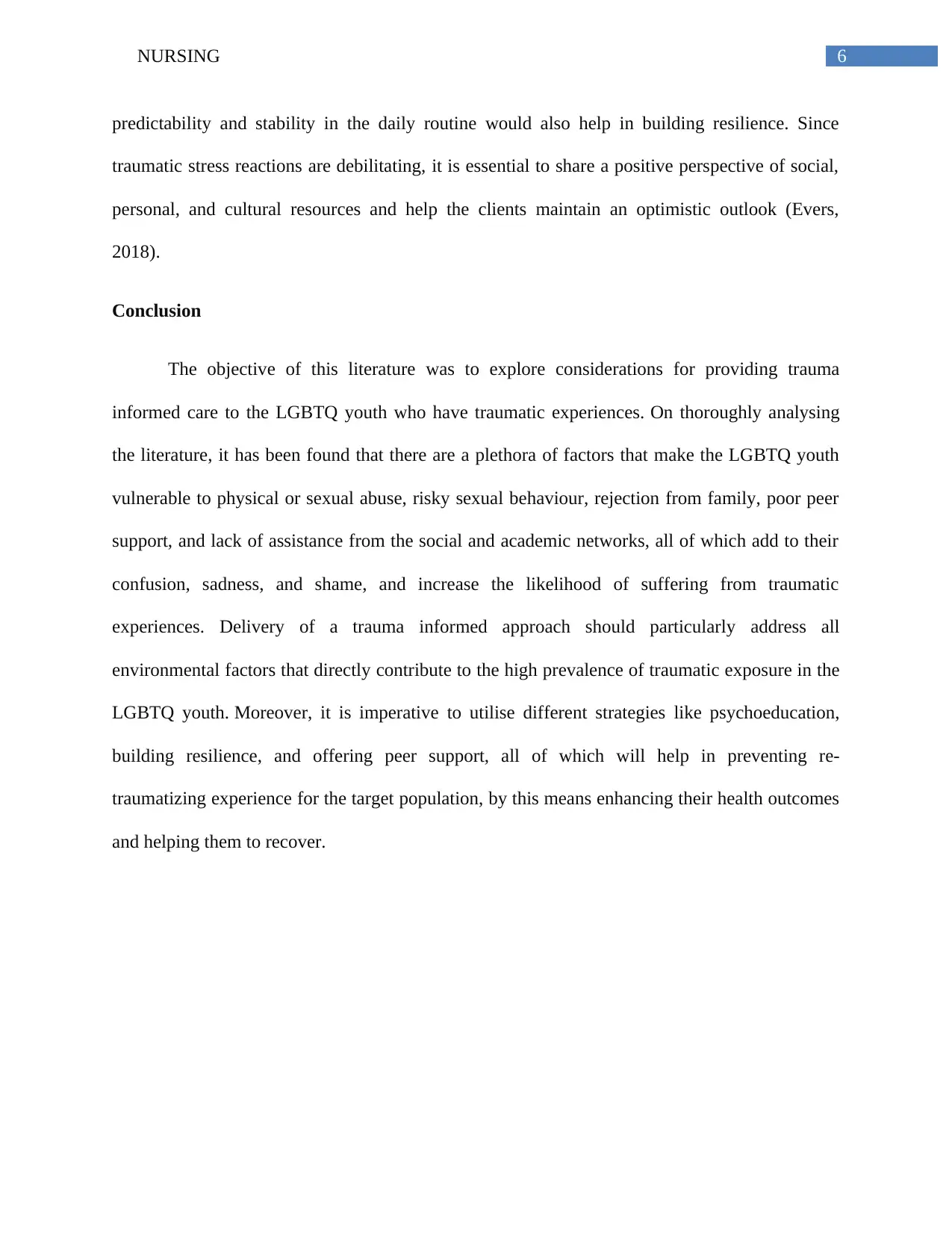
6NURSING
predictability and stability in the daily routine would also help in building resilience. Since
traumatic stress reactions are debilitating, it is essential to share a positive perspective of social,
personal, and cultural resources and help the clients maintain an optimistic outlook (Evers,
2018).
Conclusion
The objective of this literature was to explore considerations for providing trauma
informed care to the LGBTQ youth who have traumatic experiences. On thoroughly analysing
the literature, it has been found that there are a plethora of factors that make the LGBTQ youth
vulnerable to physical or sexual abuse, risky sexual behaviour, rejection from family, poor peer
support, and lack of assistance from the social and academic networks, all of which add to their
confusion, sadness, and shame, and increase the likelihood of suffering from traumatic
experiences. Delivery of a trauma informed approach should particularly address all
environmental factors that directly contribute to the high prevalence of traumatic exposure in the
LGBTQ youth. Moreover, it is imperative to utilise different strategies like psychoeducation,
building resilience, and offering peer support, all of which will help in preventing re-
traumatizing experience for the target population, by this means enhancing their health outcomes
and helping them to recover.
predictability and stability in the daily routine would also help in building resilience. Since
traumatic stress reactions are debilitating, it is essential to share a positive perspective of social,
personal, and cultural resources and help the clients maintain an optimistic outlook (Evers,
2018).
Conclusion
The objective of this literature was to explore considerations for providing trauma
informed care to the LGBTQ youth who have traumatic experiences. On thoroughly analysing
the literature, it has been found that there are a plethora of factors that make the LGBTQ youth
vulnerable to physical or sexual abuse, risky sexual behaviour, rejection from family, poor peer
support, and lack of assistance from the social and academic networks, all of which add to their
confusion, sadness, and shame, and increase the likelihood of suffering from traumatic
experiences. Delivery of a trauma informed approach should particularly address all
environmental factors that directly contribute to the high prevalence of traumatic exposure in the
LGBTQ youth. Moreover, it is imperative to utilise different strategies like psychoeducation,
building resilience, and offering peer support, all of which will help in preventing re-
traumatizing experience for the target population, by this means enhancing their health outcomes
and helping them to recover.
Paraphrase This Document
Need a fresh take? Get an instant paraphrase of this document with our AI Paraphraser
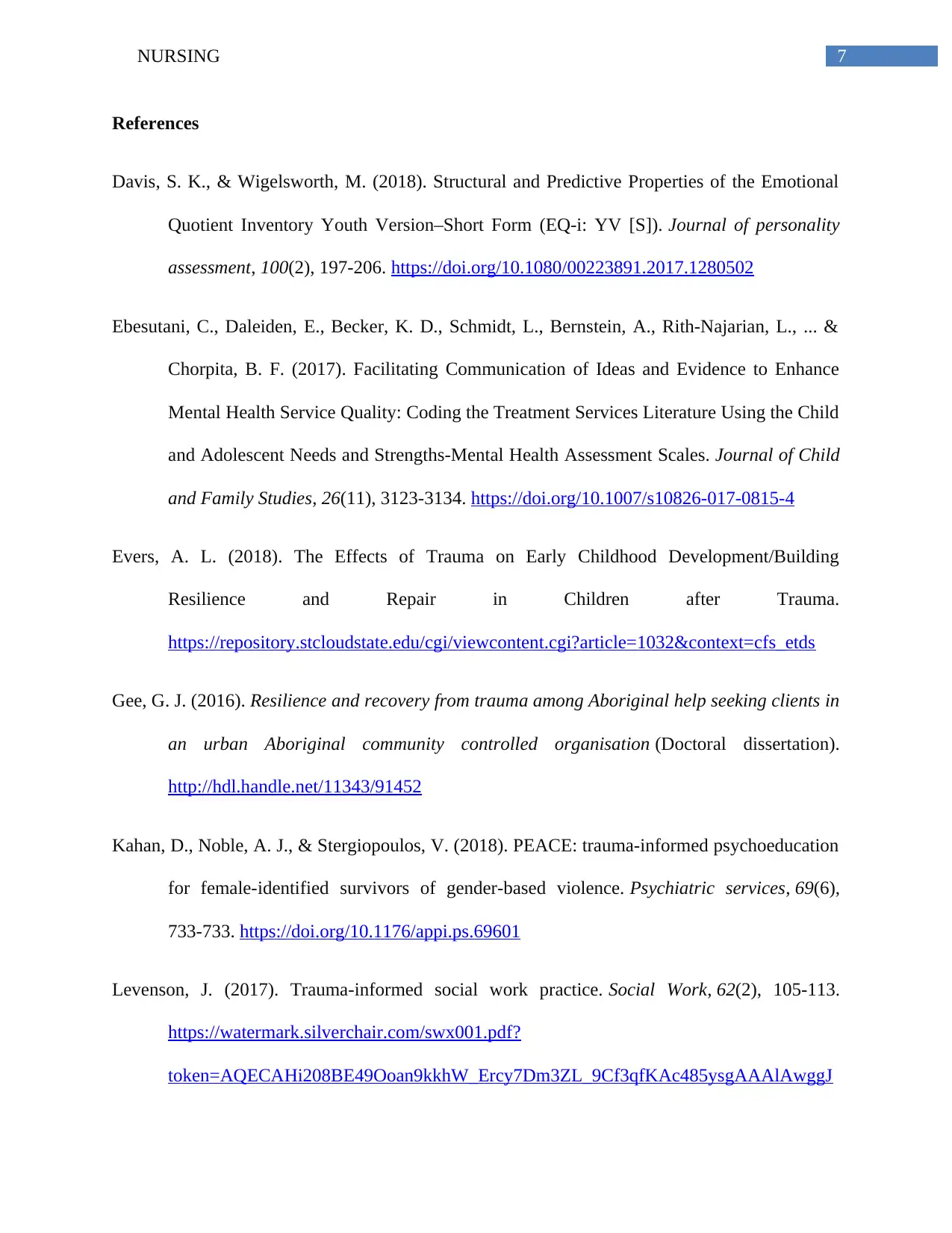
7NURSING
References
Davis, S. K., & Wigelsworth, M. (2018). Structural and Predictive Properties of the Emotional
Quotient Inventory Youth Version–Short Form (EQ-i: YV [S]). Journal of personality
assessment, 100(2), 197-206. https://doi.org/10.1080/00223891.2017.1280502
Ebesutani, C., Daleiden, E., Becker, K. D., Schmidt, L., Bernstein, A., Rith-Najarian, L., ... &
Chorpita, B. F. (2017). Facilitating Communication of Ideas and Evidence to Enhance
Mental Health Service Quality: Coding the Treatment Services Literature Using the Child
and Adolescent Needs and Strengths-Mental Health Assessment Scales. Journal of Child
and Family Studies, 26(11), 3123-3134. https://doi.org/10.1007/s10826-017-0815-4
Evers, A. L. (2018). The Effects of Trauma on Early Childhood Development/Building
Resilience and Repair in Children after Trauma.
https://repository.stcloudstate.edu/cgi/viewcontent.cgi?article=1032&context=cfs_etds
Gee, G. J. (2016). Resilience and recovery from trauma among Aboriginal help seeking clients in
an urban Aboriginal community controlled organisation (Doctoral dissertation).
http://hdl.handle.net/11343/91452
Kahan, D., Noble, A. J., & Stergiopoulos, V. (2018). PEACE: trauma-informed psychoeducation
for female-identified survivors of gender-based violence. Psychiatric services, 69(6),
733-733. https://doi.org/10.1176/appi.ps.69601
Levenson, J. (2017). Trauma-informed social work practice. Social Work, 62(2), 105-113.
https://watermark.silverchair.com/swx001.pdf?
token=AQECAHi208BE49Ooan9kkhW_Ercy7Dm3ZL_9Cf3qfKAc485ysgAAAlAwggJ
References
Davis, S. K., & Wigelsworth, M. (2018). Structural and Predictive Properties of the Emotional
Quotient Inventory Youth Version–Short Form (EQ-i: YV [S]). Journal of personality
assessment, 100(2), 197-206. https://doi.org/10.1080/00223891.2017.1280502
Ebesutani, C., Daleiden, E., Becker, K. D., Schmidt, L., Bernstein, A., Rith-Najarian, L., ... &
Chorpita, B. F. (2017). Facilitating Communication of Ideas and Evidence to Enhance
Mental Health Service Quality: Coding the Treatment Services Literature Using the Child
and Adolescent Needs and Strengths-Mental Health Assessment Scales. Journal of Child
and Family Studies, 26(11), 3123-3134. https://doi.org/10.1007/s10826-017-0815-4
Evers, A. L. (2018). The Effects of Trauma on Early Childhood Development/Building
Resilience and Repair in Children after Trauma.
https://repository.stcloudstate.edu/cgi/viewcontent.cgi?article=1032&context=cfs_etds
Gee, G. J. (2016). Resilience and recovery from trauma among Aboriginal help seeking clients in
an urban Aboriginal community controlled organisation (Doctoral dissertation).
http://hdl.handle.net/11343/91452
Kahan, D., Noble, A. J., & Stergiopoulos, V. (2018). PEACE: trauma-informed psychoeducation
for female-identified survivors of gender-based violence. Psychiatric services, 69(6),
733-733. https://doi.org/10.1176/appi.ps.69601
Levenson, J. (2017). Trauma-informed social work practice. Social Work, 62(2), 105-113.
https://watermark.silverchair.com/swx001.pdf?
token=AQECAHi208BE49Ooan9kkhW_Ercy7Dm3ZL_9Cf3qfKAc485ysgAAAlAwggJ
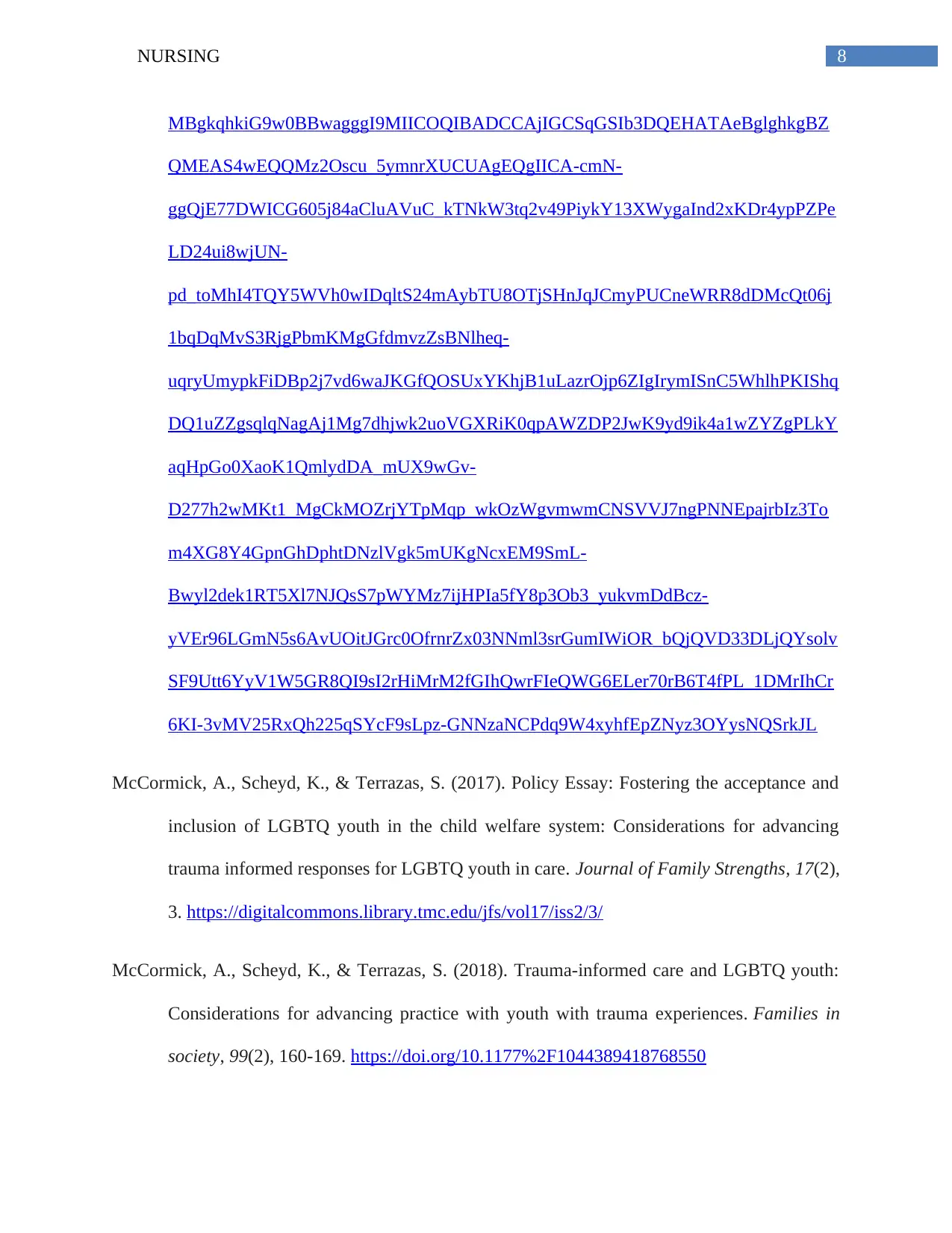
8NURSING
MBgkqhkiG9w0BBwagggI9MIICOQIBADCCAjIGCSqGSIb3DQEHATAeBglghkgBZ
QMEAS4wEQQMz2Oscu_5ymnrXUCUAgEQgIICA-cmN-
ggQjE77DWICG605j84aCluAVuC_kTNkW3tq2v49PiykY13XWygaInd2xKDr4ypPZPe
LD24ui8wjUN-
pd_toMhI4TQY5WVh0wIDqltS24mAybTU8OTjSHnJqJCmyPUCneWRR8dDMcQt06j
1bqDqMvS3RjgPbmKMgGfdmvzZsBNlheq-
uqryUmypkFiDBp2j7vd6waJKGfQOSUxYKhjB1uLazrOjp6ZIgIrymISnC5WhlhPKIShq
DQ1uZZgsqlqNagAj1Mg7dhjwk2uoVGXRiK0qpAWZDP2JwK9yd9ik4a1wZYZgPLkY
aqHpGo0XaoK1QmlydDA_mUX9wGv-
D277h2wMKt1_MgCkMOZrjYTpMqp_wkOzWgvmwmCNSVVJ7ngPNNEpajrbIz3To
m4XG8Y4GpnGhDphtDNzlVgk5mUKgNcxEM9SmL-
Bwyl2dek1RT5Xl7NJQsS7pWYMz7ijHPIa5fY8p3Ob3_yukvmDdBcz-
yVEr96LGmN5s6AvUOitJGrc0OfrnrZx03NNml3srGumIWiOR_bQjQVD33DLjQYsolv
SF9Utt6YyV1W5GR8QI9sI2rHiMrM2fGIhQwrFIeQWG6ELer70rB6T4fPL_1DMrIhCr
6KI-3vMV25RxQh225qSYcF9sLpz-GNNzaNCPdq9W4xyhfEpZNyz3OYysNQSrkJL
McCormick, A., Scheyd, K., & Terrazas, S. (2017). Policy Essay: Fostering the acceptance and
inclusion of LGBTQ youth in the child welfare system: Considerations for advancing
trauma informed responses for LGBTQ youth in care. Journal of Family Strengths, 17(2),
3. https://digitalcommons.library.tmc.edu/jfs/vol17/iss2/3/
McCormick, A., Scheyd, K., & Terrazas, S. (2018). Trauma-informed care and LGBTQ youth:
Considerations for advancing practice with youth with trauma experiences. Families in
society, 99(2), 160-169. https://doi.org/10.1177%2F1044389418768550
MBgkqhkiG9w0BBwagggI9MIICOQIBADCCAjIGCSqGSIb3DQEHATAeBglghkgBZ
QMEAS4wEQQMz2Oscu_5ymnrXUCUAgEQgIICA-cmN-
ggQjE77DWICG605j84aCluAVuC_kTNkW3tq2v49PiykY13XWygaInd2xKDr4ypPZPe
LD24ui8wjUN-
pd_toMhI4TQY5WVh0wIDqltS24mAybTU8OTjSHnJqJCmyPUCneWRR8dDMcQt06j
1bqDqMvS3RjgPbmKMgGfdmvzZsBNlheq-
uqryUmypkFiDBp2j7vd6waJKGfQOSUxYKhjB1uLazrOjp6ZIgIrymISnC5WhlhPKIShq
DQ1uZZgsqlqNagAj1Mg7dhjwk2uoVGXRiK0qpAWZDP2JwK9yd9ik4a1wZYZgPLkY
aqHpGo0XaoK1QmlydDA_mUX9wGv-
D277h2wMKt1_MgCkMOZrjYTpMqp_wkOzWgvmwmCNSVVJ7ngPNNEpajrbIz3To
m4XG8Y4GpnGhDphtDNzlVgk5mUKgNcxEM9SmL-
Bwyl2dek1RT5Xl7NJQsS7pWYMz7ijHPIa5fY8p3Ob3_yukvmDdBcz-
yVEr96LGmN5s6AvUOitJGrc0OfrnrZx03NNml3srGumIWiOR_bQjQVD33DLjQYsolv
SF9Utt6YyV1W5GR8QI9sI2rHiMrM2fGIhQwrFIeQWG6ELer70rB6T4fPL_1DMrIhCr
6KI-3vMV25RxQh225qSYcF9sLpz-GNNzaNCPdq9W4xyhfEpZNyz3OYysNQSrkJL
McCormick, A., Scheyd, K., & Terrazas, S. (2017). Policy Essay: Fostering the acceptance and
inclusion of LGBTQ youth in the child welfare system: Considerations for advancing
trauma informed responses for LGBTQ youth in care. Journal of Family Strengths, 17(2),
3. https://digitalcommons.library.tmc.edu/jfs/vol17/iss2/3/
McCormick, A., Scheyd, K., & Terrazas, S. (2018). Trauma-informed care and LGBTQ youth:
Considerations for advancing practice with youth with trauma experiences. Families in
society, 99(2), 160-169. https://doi.org/10.1177%2F1044389418768550
⊘ This is a preview!⊘
Do you want full access?
Subscribe today to unlock all pages.

Trusted by 1+ million students worldwide
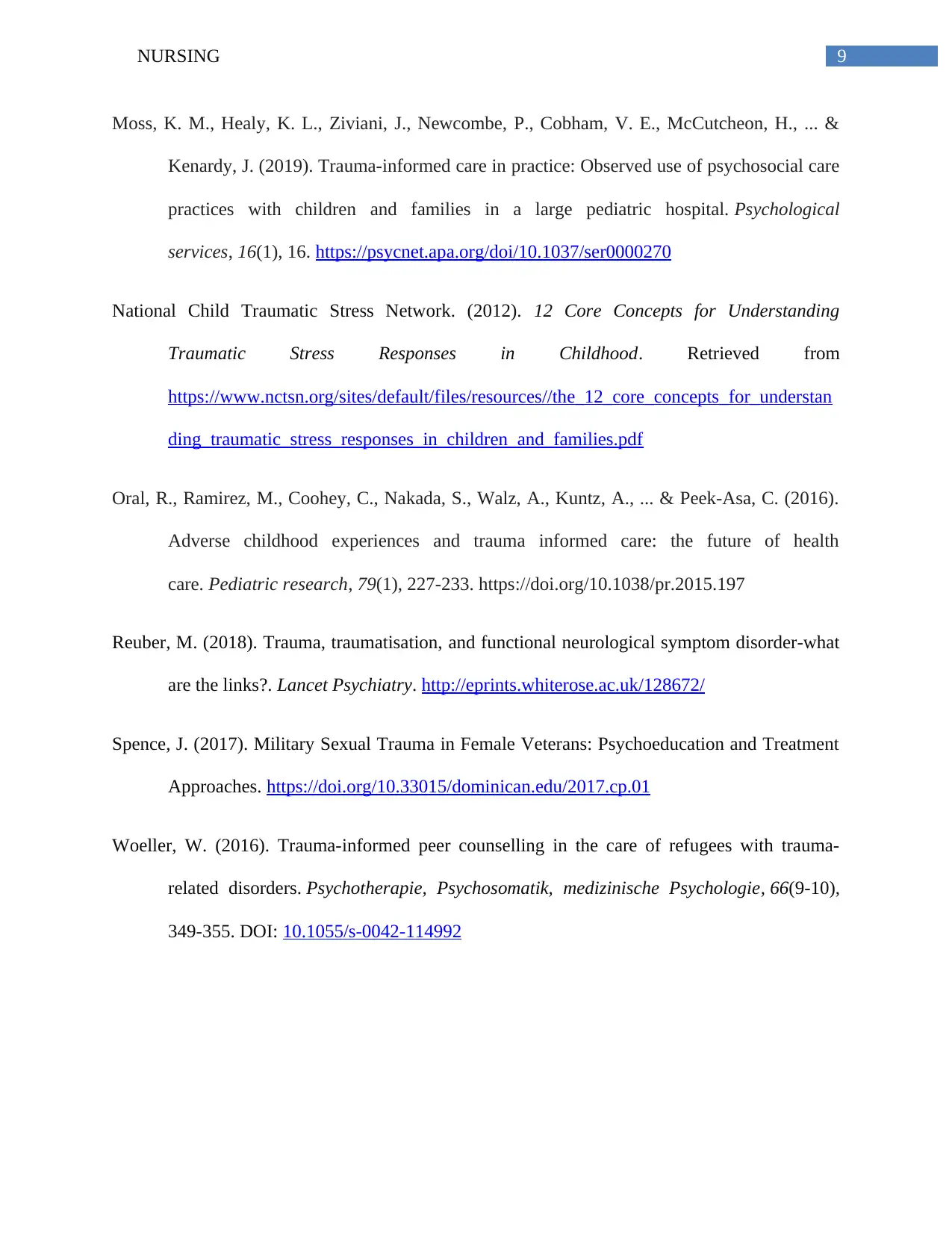
9NURSING
Moss, K. M., Healy, K. L., Ziviani, J., Newcombe, P., Cobham, V. E., McCutcheon, H., ... &
Kenardy, J. (2019). Trauma-informed care in practice: Observed use of psychosocial care
practices with children and families in a large pediatric hospital. Psychological
services, 16(1), 16. https://psycnet.apa.org/doi/10.1037/ser0000270
National Child Traumatic Stress Network. (2012). 12 Core Concepts for Understanding
Traumatic Stress Responses in Childhood. Retrieved from
https://www.nctsn.org/sites/default/files/resources//the_12_core_concepts_for_understan
ding_traumatic_stress_responses_in_children_and_families.pdf
Oral, R., Ramirez, M., Coohey, C., Nakada, S., Walz, A., Kuntz, A., ... & Peek-Asa, C. (2016).
Adverse childhood experiences and trauma informed care: the future of health
care. Pediatric research, 79(1), 227-233. https://doi.org/10.1038/pr.2015.197
Reuber, M. (2018). Trauma, traumatisation, and functional neurological symptom disorder-what
are the links?. Lancet Psychiatry. http://eprints.whiterose.ac.uk/128672/
Spence, J. (2017). Military Sexual Trauma in Female Veterans: Psychoeducation and Treatment
Approaches. https://doi.org/10.33015/dominican.edu/2017.cp.01
Woeller, W. (2016). Trauma-informed peer counselling in the care of refugees with trauma-
related disorders. Psychotherapie, Psychosomatik, medizinische Psychologie, 66(9-10),
349-355. DOI: 10.1055/s-0042-114992
Moss, K. M., Healy, K. L., Ziviani, J., Newcombe, P., Cobham, V. E., McCutcheon, H., ... &
Kenardy, J. (2019). Trauma-informed care in practice: Observed use of psychosocial care
practices with children and families in a large pediatric hospital. Psychological
services, 16(1), 16. https://psycnet.apa.org/doi/10.1037/ser0000270
National Child Traumatic Stress Network. (2012). 12 Core Concepts for Understanding
Traumatic Stress Responses in Childhood. Retrieved from
https://www.nctsn.org/sites/default/files/resources//the_12_core_concepts_for_understan
ding_traumatic_stress_responses_in_children_and_families.pdf
Oral, R., Ramirez, M., Coohey, C., Nakada, S., Walz, A., Kuntz, A., ... & Peek-Asa, C. (2016).
Adverse childhood experiences and trauma informed care: the future of health
care. Pediatric research, 79(1), 227-233. https://doi.org/10.1038/pr.2015.197
Reuber, M. (2018). Trauma, traumatisation, and functional neurological symptom disorder-what
are the links?. Lancet Psychiatry. http://eprints.whiterose.ac.uk/128672/
Spence, J. (2017). Military Sexual Trauma in Female Veterans: Psychoeducation and Treatment
Approaches. https://doi.org/10.33015/dominican.edu/2017.cp.01
Woeller, W. (2016). Trauma-informed peer counselling in the care of refugees with trauma-
related disorders. Psychotherapie, Psychosomatik, medizinische Psychologie, 66(9-10),
349-355. DOI: 10.1055/s-0042-114992
1 out of 10
Related Documents
Your All-in-One AI-Powered Toolkit for Academic Success.
+13062052269
info@desklib.com
Available 24*7 on WhatsApp / Email
![[object Object]](/_next/static/media/star-bottom.7253800d.svg)
Unlock your academic potential
Copyright © 2020–2025 A2Z Services. All Rights Reserved. Developed and managed by ZUCOL.




